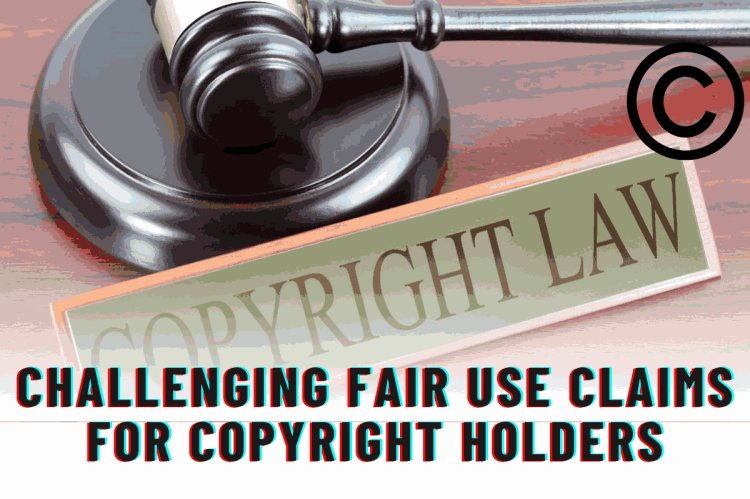Challenging Fair Use Claims for Copyright Holders
This detailed guide outlines strategies for copyright holders in India to effectively challenge fair use claims under the Indian Copyright Act, of 1957. By examining legal foundations, judicial precedents, market impact considerations, negotiation tactics, proactive monitoring, and educational outreach, copyright holders can navigate the complex landscape of copyright infringement defence. The guide further provides a comprehensive set of steps for addressing copyright infringement on YouTube, emphasizing evidence gathering, takedown notices, legal considerations, and ongoing monitoring.

Introduction
Fair use claims, when invoked as defences against copyright infringement, present unique challenges for copyright holders. In the context of the Indian Copyright Act, 1957, and considering relevant judicial decisions, here are detailed strategies that copyright holders can employ to effectively challenge fair use claims:
1. Specificity in Allegations:
- Legal Foundation: Section 52(1)(a) of the Indian Copyright Act allows fair dealing for the purpose of private use, research, criticism, or review. Copyright holders must challenge fair use claims by providing specific and detailed evidence demonstrating how the use in question does not align with the statutory factors.
- Judicial Precedent: The judgment in Eastern Book Company v. D.B. Modak (2008) underscores the importance of a case-by-case analysis, emphasizing that fair dealing provisions are not absolute. Copyright holders can use this precedent to argue for a thorough examination of the specific circumstances surrounding the alleged fair use.
2. Market Effect and Commercial Exploitation:
- Statutory Grounds: Sections 52(1)(a) and (b) of the Copyright Act highlight that fair use should not unduly prejudice the legitimate interests of copyright holders or be used for commercial exploitation. Copyright holders can challenge fair use claims by demonstrating how the use negatively impacts the market value of their work.
- Legal Authority: The judgment in R.G. Anand v. M/s. Deluxe Films (1978) established the principle that fair dealing cannot be used as a disguise for commercial exploitation. Copyright holders can leverage this authority to emphasize the statutory restriction on unfair prejudice and exploitation.
3. Negotiation and Licensing:
- Pre-Litigation Resolution: Engaging in negotiations and licensing discussions can be a strategic approach to resolving disputes without resorting to litigation. The Copyright Act encourages amicable resolution before legal proceedings (Section 52(1)(h)).
- Judicial Recognition: The judgment in Gramophone Company of India Ltd. v. Super Cassettes Industries Ltd. (2012) acknowledged the significance of parties attempting an amicable resolution. Courts often appreciate proactive steps towards negotiation, which copyright holders can leverage to showcase a genuine intent for resolution.
4. Proactive Monitoring and Communication:
- Early Detection: Copyright holders can implement robust monitoring systems to identify potential infringements at an early stage. Timely detection allows for prompt action and strengthens the position of the copyright holder.
- Clear Communication: Copyright holders can communicate clearly with potential infringers, outlining their concerns and asserting their exclusive rights. This proactive approach may dissuade infringers from relying on fair use as a defence.
5. Educational Outreach:
- Public Awareness: Copyright holders can engage in educational initiatives to raise awareness about copyright laws and fair use limitations. Educating the public on the lawful use of copyrighted material can contribute to a culture of compliance and discourage misuse.
- Collaboration with Stakeholders: Collaboration with industry associations, educational institutions, and relevant stakeholders can facilitate a collective effort to promote responsible use of copyrighted material.
The following steps can be taken to address the infringement of a video on YouTube:
1. Identify the Infringing Content: Carefully review the content that you believe infringes on your copyrighted material. Ensure that you have clear evidence of the similarities or reproduction of your original work.
2. Gather Evidence: Collect evidence of your original copyrighted work, such as timestamps, upload dates, and any other relevant information that establishes your ownership of the content.
3. File a Copyright Takedown Notice: Use YouTube's copyright infringement reporting system, commonly known as the Content ID system, to submit a takedown notice. This involves providing details about the copyrighted work, identifying the infringing content, and declaring, under penalty of perjury, that you are the copyright owner.
4. YouTube's Copyright Strike System: YouTube operates on a three-strike system for copyright infringements. If your takedown notice is successful, it will result in a copyright strike against the infringing user. After accumulating three strikes, a user's account may be terminated.
5. Consider Legal Action: If the infringement persists or if you seek further remedies, consult with legal professionals to explore the possibility of taking legal action against the infringer. This may involve sending a cease-and-desist letter or filing a lawsuit, depending on the severity of the infringement.
6. Use YouTube's Dispute Resolution: If the alleged infringer disputes the takedown, they can file a counter-notification. YouTube provides a process for resolving disputes through the counter-notification system. If the dispute persists, legal advice may be necessary.
7. Monitor for Future Infringements: Regularly monitor platforms, including YouTube, for potential infringements of your copyrighted content. Consider implementing tools or services that help track and identify unauthorized use.
Conclusion:
Copyright holders in India face unique challenges when dealing with fair use claims. To effectively challenge such claims, they should adopt a multifaceted strategy that combines legal, negotiation, and communication approaches. This includes specificity in allegations, negotiation and licensing, proactive monitoring, and utilizing YouTube's dispute resolution mechanisms. A comprehensive and strategic approach is essential for protecting their intellectual property rights under the Indian Copyright Act.












